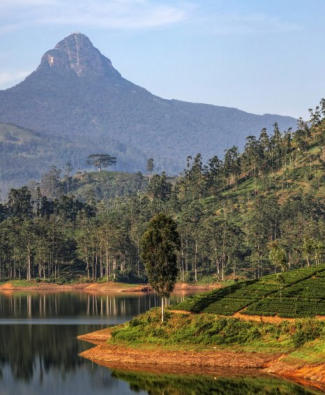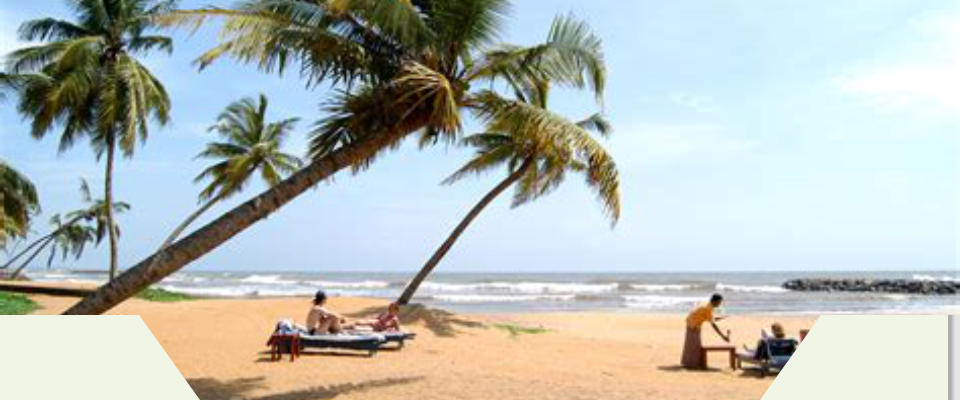




Sri Lanka
until 1972 Ceylon
officially the Democratic Socialist Republic of Sri Lanka.
Sri Lanka is a country off the southern coast of the Indian
subcontinent. Known until 1972 as Ceylon, Sri Lanka is an island
surrounded by the Indian Ocean, the Gulf of Mannar and the Palk
Strait, and lies in the vicinity of India and the Maldives. It is part of
South Asia.
As a result of its location in the path of major sea routes, Sri Lanka is a
strategic naval link between West Asia and South East Asia. It was an
important stop on the ancient Silk Road. Sri Lanka has also been a
center of the Buddhist religion and culture from ancient times and is
one of the few remaining abodes of Buddhism in South Asia along with
Ladakh, Bhutan and the Chittagong hill tracts.
Sri Lanka is a republic and a unitary state which is governed by a
semi-presidential system with its official seat of government in Sri
Jayawardenapura-Kotte, the capital. The country is famous for the
production and export of tea, coffee, coconuts, rubber and cinnamon,
the last of which is native to the country. The natural beauty of Sri
Lanka has led to the title The Pearl of the Indian Ocean. The island is
laden with lush tropical forests, white beaches and diverse landscapes
with rich biodiversity. The country lays claim to a long and colorful
history of over three thousand years, having one of the longest
documented histories in the world. Sri Lanka's rich culture can be
attributed to the many different communities on the island.
Geography of Sri Lanka
The island of Sri Lanka lies atop the Indian tectonic plate, a minor plate
within the Indo-Australian Plate. It is positioned in the Indian Ocean, to
the southwest of the Bay of Bengal, between latitudes 5° and 10°N, and
longitudes 79° and 82°E. Sri Lanka is separated from the Indian
subcontinent by the Gulf of Mannar and the Palk Strait. According to
the Hindu mythology, a land bridge existed between the Indian
mainland and Sri Lanka. It now amounts to only a chain of limestone
shoals remaining above sea level. It was eportedly passable on foot
up to 1.480 AD, until cyclones deepened the channel.
The Sinhalese community forms the majority of the population; Tamils,
who are concentrated in the north and east of the island, form the
largest ethnic minority. Other communities include Moors, Burghers,
Kaffirs, Malays and the aboriginal Vedda people.
The island consists mostly of flat-to-rolling coastal plains, with
mountains rising only in the south-central part. Amongst these is the
highest point Pidurutalagala, reaching 2.524 metres (8.281 ft) above
sea level. The climate of Sri Lanka can be described as tropical and
warm. Its position endows the country with a warm climate moderated
by ocean winds and considerable moisture.
In addition, Sri Lanka is home to over 250 types of resident birds. It has
declared several bird sanctuaries including Kumana. During the
Mahaweli Program of the 1970s and 1980s in northern Sri Lanka, the
government set aside four areas of land totalling 1.900 km² (730 sq mi)
as national parks. However the country's forest cover, which was
around 49% in 1920, had been fallen to approximately 24% by 2009.

© TsRE






Sri Lanka
until 1972 Ceylon
officially the Democratic Socialist Republic of Sri Lanka.
Sri Lanka is a country off the southern coast of the Indian
subcontinent. Known until 1972 as Ceylon, Sri Lanka is an island
surrounded by the Indian Ocean, the Gulf of Mannar and the Palk
Strait, and lies in the vicinity of India and the Maldives. It is part of
South Asia.
As a result of its location in the path of major sea routes, Sri Lanka is a
strategic naval link between West Asia and South East Asia. It was an
important stop on the ancient Silk Road. Sri Lanka has also been a
center of the Buddhist religion and culture from ancient times and is
one of the few remaining abodes of Buddhism in South Asia along with
Ladakh, Bhutan and the Chittagong hill tracts.
Sri Lanka is a republic and a unitary state which is governed by a
semi-presidential system with its official seat of government in Sri
Jayawardenapura-Kotte, the capital. The country is famous for the
production and export of tea, coffee, coconuts, rubber and cinnamon,
the last of which is native to the country. The natural beauty of Sri
Lanka has led to the title The Pearl of the Indian Ocean. The island is
laden with lush tropical forests, white beaches and diverse landscapes
with rich biodiversity. The country lays claim to a long and colorful
history of over three thousand years, having one of the longest
documented histories in the world. Sri Lanka's rich culture can be
attributed to the many different communities on the island.
Geography of Sri Lanka
The island of Sri Lanka lies atop the Indian tectonic plate, a minor plate
within the Indo-Australian Plate. It is positioned in the Indian Ocean, to
the southwest of the Bay of Bengal, between latitudes 5° and 10°N, and
longitudes 79° and 82°E. Sri Lanka is separated from the Indian
subcontinent by the Gulf of Mannar and the Palk Strait. According to
the Hindu mythology, a land bridge existed between the Indian
mainland and Sri Lanka. It now amounts to only a chain of limestone
shoals remaining above sea level. It was eportedly passable on foot
up to 1.480 AD, until cyclones deepened the channel.
The Sinhalese community forms the majority of the population; Tamils,
who are concentrated in the north and east of the island, form the
largest ethnic minority. Other communities include Moors, Burghers,
Kaffirs, Malays and the aboriginal Vedda people.
The island consists mostly of flat-to-rolling coastal plains, with
mountains rising only in the south-central part. Amongst these is the
highest point Pidurutalagala, reaching 2.524 metres (8.281 ft) above
sea level. The climate of Sri Lanka can be described as tropical and
warm. Its position endows the country with a warm climate moderated
by ocean winds and considerable moisture.
In addition, Sri Lanka is home to over 250 types of resident birds. It has
declared several bird sanctuaries including Kumana. During the
Mahaweli Program of the 1970s and 1980s in northern Sri Lanka, the
government set aside four areas of land totalling 1.900 km² (730 sq mi)
as national parks. However the country's forest cover, which was
around 49% in 1920, had been fallen to approximately 24% by 2009.

© TsRE


















